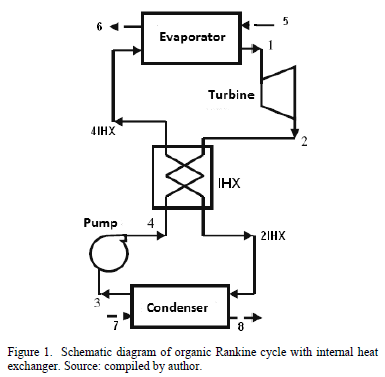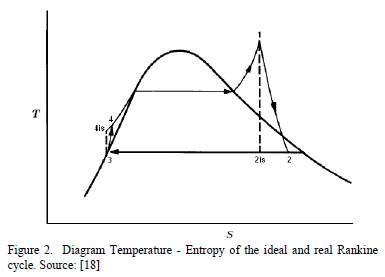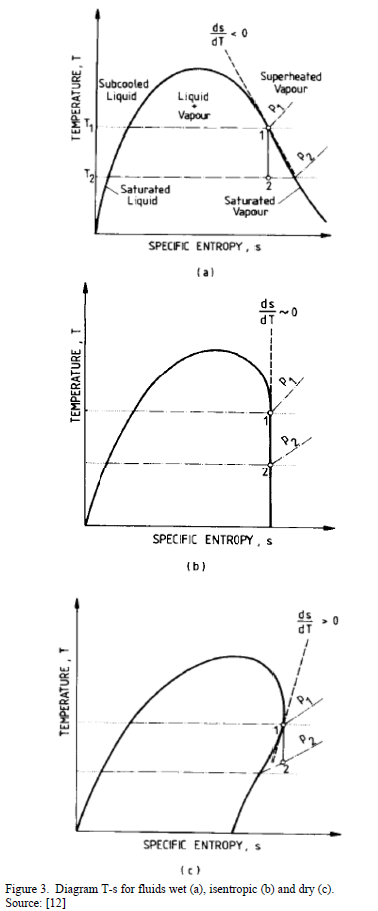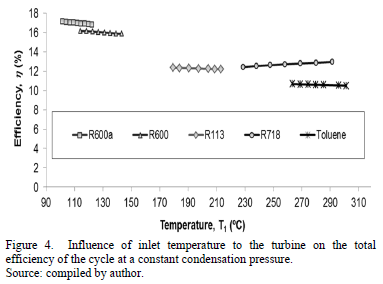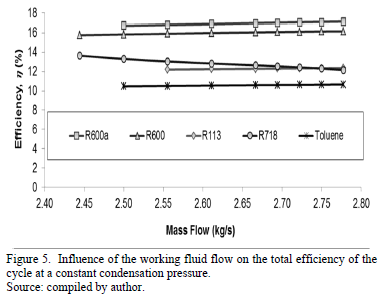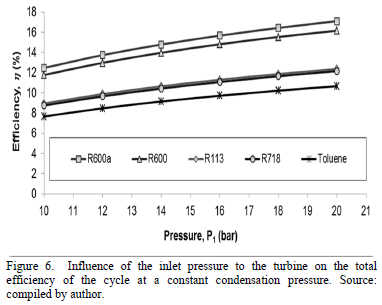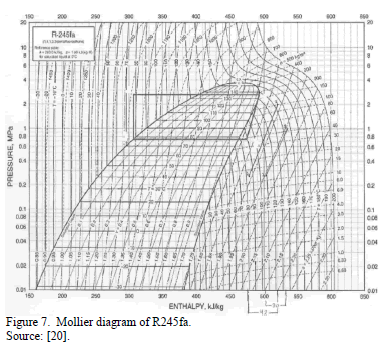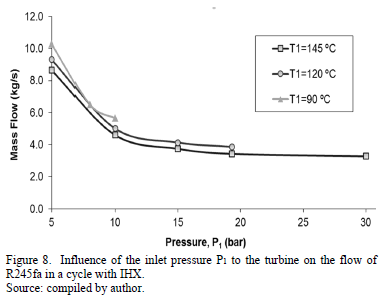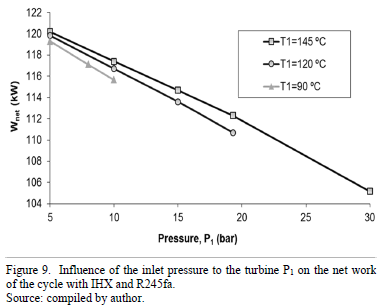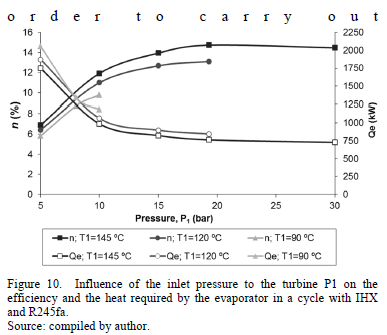Serviços Personalizados
Journal
Artigo
Indicadores
-
 Citado por SciELO
Citado por SciELO -
 Acessos
Acessos
Links relacionados
-
 Citado por Google
Citado por Google -
 Similares em
SciELO
Similares em
SciELO -
 Similares em Google
Similares em Google
Compartilhar
DYNA
versão impressa ISSN 0012-7353
Dyna rev.fac.nac.minas vol.81 no.188 Medellín nov./dez. 2014
https://doi.org/10.15446/dyna.v81n188.41666
http://dx.doi.org/10.15446/dyna.v81n188.41666
Selecting working fluids in an organic Rankine cycle for power generation from low temperature heat sources
Seleccionando fluidos de trabajo en ciclos Rankine para generación de energía a partir de fuentes de calor de baja temperatura
Fredy Vélez
Centro Tecnológico CARTIF, Valladolid, España. frevel@cartif.es
Received: January 21th, de 2014. Received in revised form: April 29th, 2014. Accepted: May 14th, 2014
Abstract
This paper presents a thermodynamic study carried out on the use of low-temperature heat sources for power generation through a subcritical Rankine cycle with organic working fluids. An analysis of the state of the art of this technology shows the selection of the working fluid as an open research line, since until now there is no fluid that can meet all environmental and technical aspects to be considered in these cycles. Hence, we have developed a series of simulations that allow us to study the behavior of the Rankine cycle with different configurations and fluids (wet, dry and isentropic) which has led us to observe the influence on the overall cycle efficiency when we change the type of fluids used (refrigerants, hydrocarbons and water) as well as the conditions of temperature, pressure, flow, etc. With the work realized, the viability of this type of processes is demonstrated for the recovery of heat in industry and/or the use of renewable sources of low and medium temperature for the production of electricity.
Keywords: energy efficiency; organic Rankine cycle; power generation; waste heat; renewable energy.
Resumen
Este trabajo presenta un estudio termodinámico realizado sobre el uso de fuentes de calor de baja temperatura para la generación de energía a través de un ciclo Rankine subcrítico con fluidos de trabajo orgánicos. Un análisis del estado del arte de esta tecnología muestra como línea de investigación abierta, la selección del fluido de trabajo, pues hasta ahora, no existe un fluido que satisfaga todos los aspectos medioambientales y técnicos a tener en cuenta en estos ciclos. Por ello, se ha desarrollado una serie de simulaciones que permiten estudiar el comportamiento del ciclo Rankine con diferentes configuraciones y fluidos (húmedo, seco e isoentrópico), permitiendo con ello observar de qué manera influyen cambios tanto en esos tipos de fluidos utilizados (refrigerantes, hidrocarburos y agua), como de condiciones de temperatura, presión, flujo, etc., sobre la eficiencia total del ciclo. Con el trabajo realizado se demuestra la viabilidad de este tipo de proceso en la recuperación de calores en la industria y/o aprovechamiento de fuentes renovables de baja y media temperatura para la producción de energía eléctrica.
Palabras clave: eficiencia energética; ciclo Rankine orgánico; generación de energía; calor residual; energías renovables.
1. Introduction
There is no doubt that the implementation of projects based on non-conventional technologies for environment-friendly energy generation, and with occupational health and safety criteria are essential to ensure social equity and to facilitate economic activities related to the public service of energy off-grid areas, mainly in underdeveloped countries where majority of the territory corresponds to isolated areas with high levels of poverty and without any opportunities for socio-economic development, which is caused, among others, by the lack of an adequate energy supply. The use of fossil fuels (e.g., oil and coal) as an energy source has many negative environmental impacts, such as the release of pollutants and resource depletion. A high consumption rate of fossil-fuels will result in an increase of environmental pollution during the next century, due to the emission of CO2 and other gases that cause global warming through what is known as the greenhouse effect [1]. These problems encourage efforts to develop new technologies that transform renewable energy sources such as solar, biomass, geothermal, as well as the use of waste and/or low-enthalpy heat now discharged in the industry (which represents a 50% or more of the heat generated therein) into electric and/or mechanical energy [2]. However, given that the traditional Rankine cycle does not present a good performance to recover or use low temperature heat, it is necessary to analyze other processes such as the Organic Rankine Cycle (ORC), which allows to leverage different sources of low temperature to power output as was proposed by [2-6] and many other authors. In this sense, the ORC is a promising process for the conversion of these low and medium temperature heat sources from renewable energy and waste heat from industry into electricity [7-10]. The ORC process works like a conventional steam Rankine cycle, with the difference that the former uses an organic compound of low boiling point as the working fluid (refrigerant and hydrocarbon) instead of water vapor, thereby reducing the evaporation temperature. In recent years, commercial applications of this technology, with power ranges from 200-2000 kWe, have increased sharply worldwide. ORMAT, Barber-Nichols, UTC Power, Turboden, etc, are some of the companies that have developed plants for using geothermal energy, waste heat in industry, biomass, etc.
However, lower power modules are in a prototype stage due to lack of appropriate equipment (mainly the turbine) and the difficulty in selecting a suitable working fluid [3]. The latter characteristic has great influence on the design and behavior of the process [6], because the fluid must have optimal thermodynamic properties at low temperatures and pressures and also satisfy many criteria such as being economical, nontoxic, nonflammable, environmentally friendly, and allow high utilization of the available energy from the heat source, etc; all depending on the application, the source and the heat level to use. If all these aspects are considered, very few fluids can be used [3,11]. In [11], it is shown that these working fluid properties are keys in the performance cycle. In addition, the low temperatures that take advantage of the ORC cause that the efficiency of the cycle is highly sensitive to inefficiencies in heat transfer, which depends strongly on the thermodynamic properties of the fluid and the conditions to which it is operating. A study of 68 potential working fluids conducted in [12] in 1985, gave the best results only for three of them (R11, R113 and R114) which are nowadays not recommended by global environmental conservation policies [13]. In [2], ORC efficiency was analyzed using azeotropic mixtures of 85-fluorinol, 2-methyl pyridine/water and substances such as benzene, ammonia, R134a, R113, R11 and R12, achieving greater efficiencies for the last two, however, they are substances of limited use. Other researchers who have analyzed the characteristics and outcomes of different fluids for use in ORC systems are among others [4, 6-12] and [14-16], of whose research can conclude that: R245fa and R134a as good candidates in subcritical cycles and CO2 in transcritical cycles for processes whose heat source is low temperature. Recent publications such as [17] have studied the behavior of R134a, R123, R227ea, R245fa, R290, and n-pentane from the point of view of energy production capacity and component size. They have shown the existence of an optimum pressure that minimizes the heat exchange area, which obviously depends on the source and the source temperature. In [11], a review of thermodynamic properties, physical stability, environmental impact, safety, cost and availability of 35 possible fluids to be used in a Rankine cycle for the conversion of low temperature heat into electricity has been performed.
The present paper analyzes the behavior of working fluids, such as water and some hydrocarbons and refrigerants in a Rankine cycle in different configurations and conditions of temperature, pressure and flow, thus establishing the viability of this type of process in the recovery and/or utilization of low-temperature energy.
Nowadays, there is no a unique fluid that fulfills all aspects to be considered to use in ORC cycles. This study has selected R600, R600a, R113, R718, R425fa and Toluene, trying to encompass and take into account the optimal physical and thermodynamic properties, economic, toxicity, flammability, environmental friendly (with null Ozone Depletion Potential (ODP) and Global Warming Potential (GWP)). Of the fluids selected, R600a and R600 are hydrocarbons used as refrigerants with zero potential degradation of the ozone layer and very low global warming potential, however, they are highly flammable. Toluene is similar in its behavior, with the drawback of its toxicity. Refrigerant R113 is not flammable, nor toxic, but has high global warming potential and high destruction potential of the ozone layer. R245fa is a safe refrigerant, nonflammable, nontoxic, has zero ozone degradation potential, relatively high molecular weight, good thermophysical properties, but has a moderate potential for global warming. Finally, water (R718), as reference fluid to the being the working fluid in the conventional Rankine cycle.
Additionally, in this study the difference in the type of fluid has been considered and thus, the results obtained enable to determine whether the increase in the inlet temperature increases or decreases turbine cycle performance qualitatively but also, allows to know how this increases or decreases.
2. Description of the cycle
The operating principle of the ORC is the same as the conventional Rankine cycle. A pump pressurizes the liquid fluid, which is injected into an evaporator to produce a vapor that is expanded in a turbine connected to a generator. Finally, the steam is condensed and sucked by the pump, starting the cycle again. It may also include an internal heat exchanger (IHX) to further exploit the energy of the expanded steam, preheating the fluid exiting the pump and entering the evaporator, as is shown in Fig. 1.
Figure 2 represents the power cycle on a T-s diagram according to the state points displayed in the flow diagram of Fig. 1. As an example, an ideal cycle process is shown by the segments constructed from state points 1, 2is, 3 and 4is. Line segment 1-2is represents an isentropic expansion with work production. Heat is extracted from 2is to 3, through a constant subcritical pressure line to subsequently result to ideal compression of the subcooled liquid from the pressure at state point 3 to state point 4is. Finally, the segment 4is-1 corresponds to the heat added to a constant subcritical pressure up to the highest temperature point in the cycle in the state point 1.
A cycle, in which both the expansion and the compression are not ideal, is reproduced by segments in points 1, 2, 3 and 4 of the same Fig. 2.
3. Selection of the working fluid
As mentioned previously, the selection of the working fluid for use in ORC cycles is a crucial point, because depending on the application, the source and the heat level to use, the fluid must have optimal thermodynamic properties at lowest temperatures and pressures and also satisfy several criteria such as being economical, nontoxic, nonflammable, environmentally friendly, allow a high utilization of the available energy from the heat source, among others [3]. This limits the list to only a few fluids when considering all restrictions.
Some of these limitations are [3]:
Environmental: Some fluids are restricted by International Agreements depending on their Ozone Depletion Potential (ODP) defined and limited by Montreal Protocol or Global Warming Potential (GWP) by Kyoto Protocol, which, intend to prevent the destruction of the ozone layer and emission of gases that cause the greenhouse effect, respectively.
Security: The fluid must be non-toxic (because of the problems that can occur in the case of leaks in the atmosphere or in handling), non-corrosive (it obviously avoids major maintenance costs and/or installation damage) and non-flammable. For this, the standard security classification 34 of ASHRAE is often used as an indicator of the danger level of fluids.
Stability: The chemical stability of the used fluid limits the heat source temperature. When fluids are exposed to certain temperatures, they could decompose, producing substances which could cause a different cycle operation to that initially designed. Moreover, toxic and irritating compounds could induce health problems in case leaks occur.
Pressure: A fluid requiring high pressure to achieve an efficient process increases the cost of equipment due to the greater resistance required, increasing also the complexity of the plant.
Availability and low cost: A fluid of low availability and/or high cost limits its use in ORC plants for obvious reasons in the financial viability of the projects.
Latent heat and molecular weight: With higher molecular weight and the latent heat of the fluid, more energy from the heat source in the evaporator will be absorbed and, thus, reducing the size of the installation and use of the pump due to lower mass flow required.
Low freezing point: The freezing point of the fluid must be lower than the lowest temperature of the cycle.
Curve of saturation: The thermodynamic properties of the fluid imply that the slope of the saturation curve thereof is negative, vertical or positive, which markedly affecting the design and efficiency of the ORC. In Fig. 3.a, b and c, a schematic diagram is shown of Temperature - Entropy (T-s) for fluids with a negative saturation curve (a), vertical (b) and positive (c), called wet, isentropic and dry, respectively. Since the objective of the ORC focuses on the use of heat of low and medium temperature, the overheating of steam as in a conventional Rankine cycle is not appropriate. Furthermore, as is seen in Fig. 3.a, when a wet fluid is expanded without overheating (represented by the segment of points 1-2), it falls in the liquid/vapor zone causing damages to the expander and cycle inefficiencies. This happens, among other reasons, because of the phase shift.
Nevertheless, the contrary occurs with isentropic and dry fluids which, without any type of overheating, suffer expansion falling into the saturated vapor zone, Fig. 3.b, and/or superheated, Fig. 3.c, respectively, and thus, in the latter case, it could include an internal heat exchanger to the cycle which allows to use even more the energy from the expanded steam, preheating fluid from the pump to enter the evaporator, thereby increasing the efficiency of the cycle.
In summary, for an organic Rankine cycle, the ideal working fluid will be that whose saturated vapor line is parallel to the expansion of the turbine, ensuring maximum efficiency. In this case, turbine will be always working in the dry steam area. If both lines converge, the turbine would operate in the wet steam region. In order to avoid this, it should superheat the working fluid before the expansion. If, however, the lines mentioned above were divergent, the output fluid from the turbine would exit overheated. This would increase significantly the size of the condenser surface, an aspect that is related to the operating pressure. The major disadvantage of ORC is its relatively low efficiency (inherent to the thermodynamic constraints) and the relatively large sizes of heat exchangers equipment.
4. Modelling of the process
In both cycles, the equations used for performance calculation assume steady state and constant efficiencies of 75% for both the pump and the turbine. In addition, there are no heat or pressure losses in the evaporator, heat exchanger or pipes, and an overall cycle efficiency (h) is considered as:

Where,  is the power, "t" refers the turbine, "p" to the pump and "e" evaporator. Hence:
is the power, "t" refers the turbine, "p" to the pump and "e" evaporator. Hence:

 is the mass flow,
is the mass flow,  is the enthalpy in the state point "i".
is the enthalpy in the state point "i".
Whereas  is the heat input in the evaporator defined as:
is the heat input in the evaporator defined as:

Through the theoretical basis presented in the preceding sections and using the software HYSYS®, a series of simulations has been developed that allows to study the behavior of the ORC with different configurations and fluids (as refrigerants, hydrocarbons and even water), thereby observing how the changes influence the overall cycle efficiency for these types of fluids used varying conditions of temperature, pressure, flow, etc.,. This simulator is useful for thermodynamic analysis, especially in steady-state conditions, and it has the advantage of including fluid properties and optimization tools. Its predictions have been compared with those of [19] and the results are very similar. The flow chart of the simulation is the same as it was presented in Fig. 1, and the method to solve all the components is fully described in [7,10] and [14].
5. Results and discussions
The results obtained with the simulations for water, hydrocarbons R600, R600a, Toluene and refrigerants R113 and R245fa are shown in this section.
5.1. Working Fluids: Water, R600, R600a, Toluene and R113
5.1.1. Influence of inlet temperature in the turbine on the overall cycle efficiency
The influence of inlet temperature to the turbine on the overall cycle efficiency is presented in Fig. 4. Here, conditions of input and output pressure in the turbine and the fluid flow are kept constant for the five fluids analyzed and for the different simulations carried out with values of 20 bar, 2 bar and 2.8 kg/s, respectively. It is evident that the efficiency increases linearly with the inlet temperature to the turbine in the case of R718 (Water). Unlike this wet fluid, the dry fluids R600, R600a, R113 and Toluene showed a decrease of efficiency with the increase in inlet temperature to the turbine.
Thus, there is a big difference in the efficiencies obtained according to the type of fluid used, the highest efficiency obtained is for the case of R600a, followed by R600, R718, R113 and Toluene. It is also interesting to note that as Fig. 4 shows, the use of one fluid or another will depend on the heat source that is intended to be recovered, and the thermophysical properties of the fluid, since there are fluids which would obtain relatively high efficiencies at relatively low temperature ranges when compared to other fluids that are useful in other temperature ranges.
5.1.2. Influence of the working fluid flow on the overall efficiency of the cycle
Fig. 5 shows the influence of the working fluid flow on the efficiency of the cycle with the condensation pressure constant and equal (2 bar) for all the studied fluids, maintaining constant in addition the inlet pressure to the turbine at 20 bar for the five fluids analyzed and for all simulations realized whereas the rate of energy supplied to the evaporator is also constant for all simulations carried out but different for each fluid. Values achieved were 1500 kW, 1650 kW, 7778 kW, 795 kW and 2270 kW for the R600a, R600, R718, R113 and Toluene, respectively. Thermodynamic properties of each fluid are different, therefore, for the same state point, different values of enthalpy, entropy, etc., could be obtained for two or more types of fluids. In addition, the molecular weight and the vaporization latent heat of a specific fluid, determines the amount of fluid flow (greater or smaller) that is required to have to a given power, compared to other fluid. In this sense, to make the flow values similar, i.e. to keep them in
the same range, the input power to the evaporator was fixed, for the range of study. In Fig. 5, it is observed that a slight influence exists of the working fluid on the overall efficiency of the cycle for the case of R600a, R600, R113 and Toluene, whereas for the R718, the effect is clear but opposite to that shown previously, i.e, a decrease of the cycle efficiency when the flow of R718 increases.
5.1.3. Influence of the input pressure to the turbine on the overall efficiency of the cycle.
Based on the results shown in Fig. 4 and Fig. 6, the influence of the input pressure to the turbine on the overall efficiency of the cycle is analyzed, the fluid flow of 2.8 kg/s was held constant for the five fluids analyzed and for the different simulations, the rate of energy supplied to the evaporator is also constant for the different simulations but different for each fluid and whose values were 1500 kW, 1650 kW, 7778 kW, 795 kW and 2270 kW for R600a, R600, R718, R113 and Toluene, respectively. Fig. 6 shows that the system gains in efficiency with the increase of the input pressure to the turbine. Results are consistent for all the fluids utilized. Higher input pressures to the turbine raise the net work that leads to an improvement of the efficiency.
Although the efficiency of the system also increases when the pressure of the system rises, this increase of the pressure in the system is not always feasible for economic reasons since the capital costs for the waste heat of a boiler and piping systems, as well as the complexity of the system and the component selection of the materials must also be taken into account.
5.2. Working fluid: R245fa
As it was discussed in the introduction to this paper, the refrigerant R245fa is a very promising working fluid for using in low temperature ORC because it meets many of the aspects to be considered in these applications. The R245fa fluid is a safe refrigerant (nonflammable, nontoxic), has a potential ozone degradation of zero, relatively high molecular weight, good thermophysical properties (critical temperature and pressure, boiling point, etc.), has a positive saturation curve, which gives higher yields, allowing the preheating of the fluid exiting the pump using the steam exiting the turbine, etc. However, it has a moderate potential for global warming as its main disadvantage.
For those reasons, the approach to the thermodynamic study of this fluid has been done differently from that illustrated in the previous section. In this case, we have analyzed the effect of inlet pressure and temperature to the turbine on the other parameters (efficiency, flow, net work and heat supplied to the evaporator) to an ORC with a fixed output gross power of 125 kWe and an IHX to preheat the liquid fluid from the pump with the output steam from turbine (see Fig. 1). Simulations considered a P2=2.5 bar and a condensing temperature of the working fluid (T3) of 39.7°C. In addition, the heat required for the evaporator ( ) does not take into account the efficiency for example from boiler and heat transfer in the heat exchanger.
) does not take into account the efficiency for example from boiler and heat transfer in the heat exchanger.
5.2.1. Influence of the inlet pressure to the turbine on the fluid flow in the cycle
As in this analysis, the work produced by the turbine ( ) was constant and equal to 125 kWe for all simulations, it can be stated that: keeping the condition of turbine discharge constant P2=2.5 bar and considering the fact that the work produced by the turbine is given by the eq. (2), and, supported by the Mollier diagram of this fluid (Fig. 7), we see that, for any constant inlet temperature to the turbine (for example, T1=145°C), increasing the inlet pressure to the turbine (P1), the delta enthalpy, Dh, increases from 30 kJ/kg to 42 kJ/kg (segment 1-2, red and blue colors of this Fig. 7, respectively) and therefore, the mass flow (
) was constant and equal to 125 kWe for all simulations, it can be stated that: keeping the condition of turbine discharge constant P2=2.5 bar and considering the fact that the work produced by the turbine is given by the eq. (2), and, supported by the Mollier diagram of this fluid (Fig. 7), we see that, for any constant inlet temperature to the turbine (for example, T1=145°C), increasing the inlet pressure to the turbine (P1), the delta enthalpy, Dh, increases from 30 kJ/kg to 42 kJ/kg (segment 1-2, red and blue colors of this Fig. 7, respectively) and therefore, the mass flow ( ) necessarily decreases (for any of the three temperatures studied 90°C, 120°C and 145°C), as depicted in Fig. 8 and thus to maintain constant value of the work produced by the turbine.
) necessarily decreases (for any of the three temperatures studied 90°C, 120°C and 145°C), as depicted in Fig. 8 and thus to maintain constant value of the work produced by the turbine.
5.2.2. Influence of the inlet pressure to the turbine on the net work of the cycle
Likewise, as is shown in Fig. 9, as inlet pressure increases in the turbine, it causes a decrease in the net work produced by the system ( ), because for the turbine work to be constant with increasing pressure, the work consumed by the pump is increased for any of the three temperatures studied 90°C, 120°C and 145°C.
), because for the turbine work to be constant with increasing pressure, the work consumed by the pump is increased for any of the three temperatures studied 90°C, 120°C and 145°C.
5.2.3. Influence of the inlet pressure to the turbine on the efficiency and the heat required in the cycle.
Similarly, and despite what was discussed above, the net work ( ) always decreases with increasing inlet pressure to the turbine P1, system efficiency increases, as is shown in Fig. 10. This occurs because increasing such pressure P1, as is seen in Fig. 10, the amount of heat required in the evaporator decreases with a decreasing mass flow (Fig. 8). This is produced because the mass needed to be heated/evaporated to maintain the work produced by the turbine constant is less with respect to its own net work.
) always decreases with increasing inlet pressure to the turbine P1, system efficiency increases, as is shown in Fig. 10. This occurs because increasing such pressure P1, as is seen in Fig. 10, the amount of heat required in the evaporator decreases with a decreasing mass flow (Fig. 8). This is produced because the mass needed to be heated/evaporated to maintain the work produced by the turbine constant is less with respect to its own net work.
The previous situation occurs until that by the own characteristics of this fluid, there is a specific value for the pressure (the optimum in efficiency terms), in which an increase of the variable P1 induces a negligible increase of Dh (see Fig. 7), and therefore, a lower value of the mass flow, causing the heat from the evaporator to drop a little but with sufficient value to counteract the decrease in the net work and therefore maintaining the efficiency nearly constant. In this case, and according to Figs. 8 to 10, this optimum inlet pressure to the turbine is close to 20 bar for the temperature 145°C, 15 bar for the temperature 120°C and 10 bar for 90°C.
4. Conclusions
Based on the discussed in this paper, ORC technology seems to have an enormous potential with renewable energy sources such as biomass, solar and geothermal energy as well as waste heat from industrial processes or other cycle for transforming low temperature heat sources into electricity. However, the thermophysical properties, environmental impact, safety and stability as well as its availability and cost, play a critical role in the selection of the working fluid in these cycles.
Additionally, according to research carried out in this work, it can be concluded that using organic working fluids in Rankine cycles, relatively good efficiencies are obtained recovering and/or using heats of low/medium temperature to convert them into electricity.
Acknowledgements
Fredy Vélez would like to thank the scholarship granted by the "Programa Iberoamericano de Ciencia y Tecnología para el Desarrollo", CYTED, CARTIF Technological Center and the University of Valladolid in order to carry out his doctoral thesis, on which this paper is based. In addition, the author expresses his special gratitude to the Department of Renewable Energy Service of the Spanish Company Nicolás Correa, SA, for all the technical support provided in the preparation of this research.
References
[1] Realpe, A. and Diazgranados, J. A. Electricity generation and wind potential assessment in regions of Colombia. Dyna, 79(171), pp. 116-122, 2012. [ Links ]
[2] Hung, T. C., Shai, T. Y. and Wang, S. K. A review of organic Rankine cycles (ORC`s) for the recovery of low-grade waste heat. Energy, vol. 22(7), pp. 661-667, 1997. http://dx.doi.org/10.1016/S0360-5442(96)00165-X [ Links ]
[3] Vélez, F., Segovia, J., Martín, M. C., Antolín, G., Chejne, F. and Quijano A. A Technical, economical and market review of organic rankine cycles for the conversion of low-grade heat for power generation. Renewable & Sustainable Energy Reviews, 16(6) pp. 4175- 4189, 2012. http://dx.doi.org/10.1016/j.rser.2012.03.022 [ Links ]
[4] Saleh, B., Koglbauer, G., Wendland, M. and Fischer, J. Working fluids for low temperature organic Rankine cycles. Energy, vol. 32(7), pp. 1210-1221, 2007. http://dx.doi.org/10.1016/j.energy.2006.07.001 [ Links ]
[5] Quoilin, S., Declaye, S., Tchange, B. F. and Lemort, V. Thermo-economic optimization of waste heat recovery organic Rankine cycles. Applied Thermal Engineering, 31(14), pp. 2885-2893, 2011. http://dx.doi.org/10.1016/j.applthermaleng.2011.05.014 [ Links ]
[6] Tchange, B.F., Papadakis, G., Lambrinos, G. and Frangoudakis, A., Fluid selection for a low-temperature solar organic Rankine cycle. Applied Thermal Engineering, 29(1), pp. 2468-2476, 2009. http://dx.doi.org/10.1016/j.applthermaleng.2008.12.025 [ Links ]
[7] Vélez, F., Chejne, F., Antolín, G. and Quijano, A. Theoretical analysis of a transcritical power cycle for power generation from waste energy at low temperature heat source. Energy Conversion and Management, vol. 60, pp.188-195, 2012. http://dx.doi.org/10.1016/j.enconman.2012.01.023 [ Links ]
[8] Mago, P. J., Chamra, L. M., Srinivasan, K. and Somayaji, C. An examination of regenerative organic Rankine cycles using dry fluids. Applied Thermal Engineering, 28(8), pp. 998-1007, 2008. http://dx.doi.org/10.1016/j.applthermaleng.2007.06.025 [ Links ]
[9] Schuster, A., Karellas, S., Kakaras, E. and Spliethoff, H., Energetic and economic investigation of organic Rankine cycle applications. Applied Thermal Engineering, 29(8-9), pp. 1809-1817, 2009. http://dx.doi.org/10.1016/j.applthermaleng.2008.08.016 [ Links ]
[10] Vélez, F., Segovia, J., Chejne, F., Antolín, G., Quijano, A. and Martín, M.C. Low temperature heat source for power generation: exhaustive analysis of a carbon dioxide transcritical power cycle. Energy, 36(9), pp. 5497-5507, 2011. http://dx.doi.org/10.1016/j.energy.2011.07.027 [ Links ]
[11] Chen, H., Goswami, Y. and Stefanakos, E. A review of thermodynamic cycles and working fluids for the conversion of low-grade heat. Renewable and Sustainable Energy Reviews, 14(9), pp. 3059-3067, 2010. http://dx.doi.org/10.1016/j.rser.2010.07.006 [ Links ]
[12] Badr, O., Probert, S. D. and O'callaghan, P.W., Selecting a working fluid for a Rankine-cycle engine. Applied Energy, 21(1), pp. 1-42, 1985. http://dx.doi.org/10.1016/0306-2619(85)90037-6 http://dx.doi.org/10.1016/0306-2619(85)90072-8 http://dx.doi.org/10.1016/0306-2619(85)90033-9 [ Links ]
[13] U.S. Environmental Protection Agency. Class I Ozone Depleting Substances. [Online]. [date of reference March 11th of 2013] Available at: www.epa.gov/ozone/science/ods/classone.html. [ Links ]
[14] Velez, F., Segovia, J., Martín, M. C., Antolín, G., Chejne, F. and Quijano, A. Comparative study of working fluids for a Rankine cycle operating at low temperature. Fuel Processing Technology, vol. 103, pp. 71-77, 2012. http://dx.doi.org/10.1016/j.fuproc.2011.09.017 [ Links ]
[15] Yamamoto, T., Furuhata, T., Arai, N. and Mori, K. Design and testing of the organic Rankine cycle. Energy, 26(3), pp. 239-251, 2001. http://dx.doi.org/10.1016/S0360-5442(00)00063-3 [ Links ]
[16] Drescher, U. and Brüggemann, D. Fluid selection for the organic Rankine cycle (ORC) in biomass power and heat plants. Applied Thermal Engineering, 27(1), pp. 223-228, 2007. http://dx.doi.org/10.1016/j.applthermaleng.2006.04.024 [ Links ]
[17] Lakew, A., Bolland, O. Working fluids for low temperature heat source. Applied Thermal Engineering, 30(10), pp. 1262-1268, 2010. http://dx.doi.org/10.1016/j.applthermaleng.2010.02.009 [ Links ]
[18] Monsalve, E., Cecchi, P., Vidal, A., Zuñiga, A. Informe I: Ciclo de Rankine., Departamento de Ingeniería Mecánica, Facultad de Ciencias Físicas y Matemáticas, Universidad de Chile, Santiago de Chile, Chile, 2008. [ Links ]
[19] Lemmon, E. W., Huber, M. L. and Mclinden, M. O. Reference fluid thermodynamic and transport properties (REFPROP). NIST Standard Reference Database 23, Version 8.0; 2007. [ Links ]
[20] Organic-rankine-cycle.blogspot. [en línea] [date of reference January 15th of 2014]. Available at: http://goo.gl/Oj7sxf. [ Links ]
F. Vélez, PhD. in Energetic and Fluid-Mechanical Engineering by University of Valladolid (2011). MSci in Engineering -Emphasis in Chemical Engineering- (2007) and Chemical Engineering (2004), both by Colombian National University, where he was also an Associate Professor at the Energy and Process School. He started to work as researcher in the field of renewable energies in 2004. Since 2007 he is actively working in the Energy Department of CARTIF in RTD projects about energy efficiency and integration of renewable energy (solar, geothermal, biomass) for the production of heating and cooling and/or electricity generation in buildings (to achieve zero emission buildings and near-zero energy balance) and industrial processes. He has experience in national and international (European and Latin American) projects, and has published many papers in peer review and technical journals and contributions in conferences about these themes. ORCID 0000-0003-0764-1321













